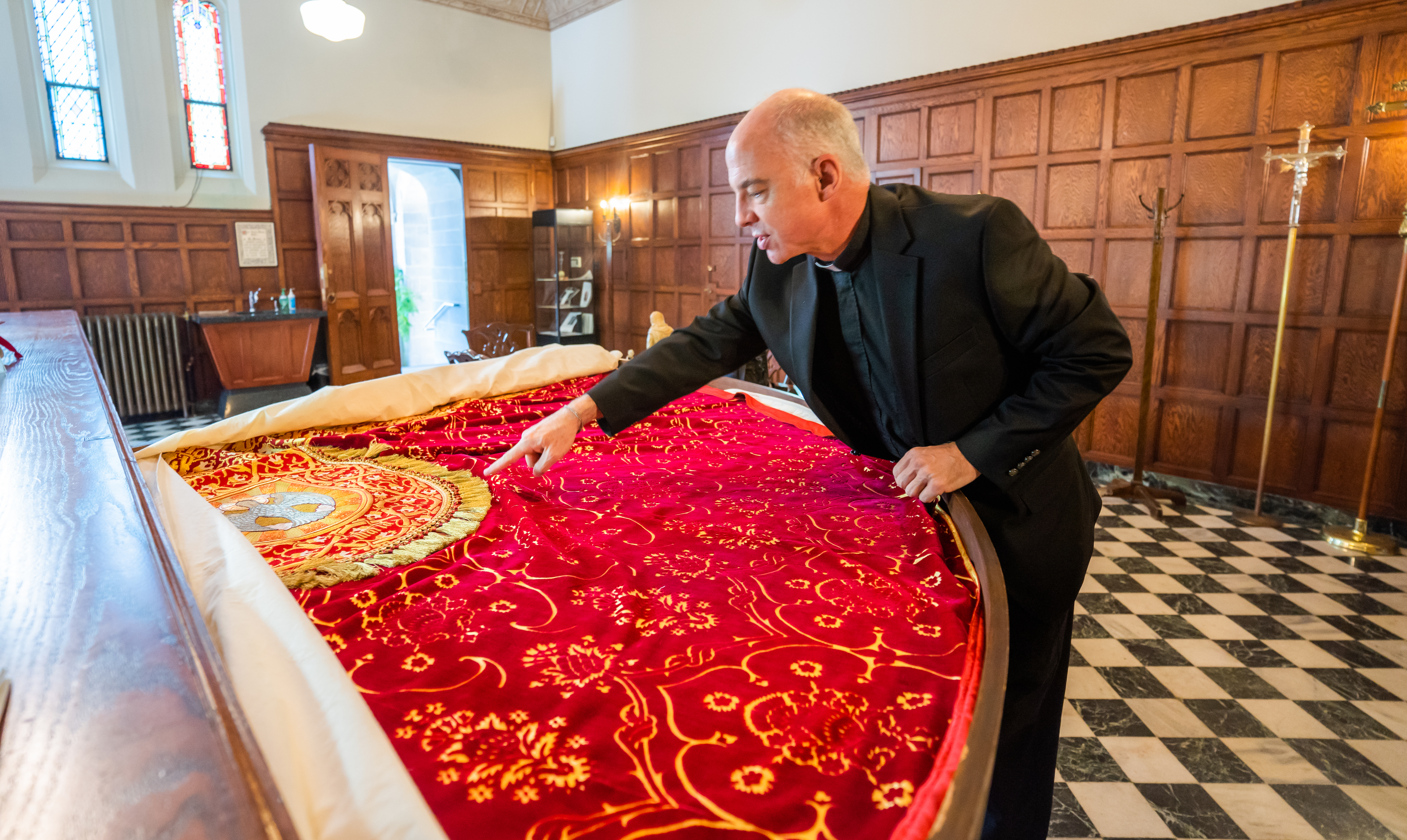Master plan calls for an outdoor Marian grotto, life-size crucifix on cathedral grounds, statues and relics of the 12 apostles and St. Paul
During September and October, Detroit Catholic is asking readers to prayerfully consider a gift to the Catholic Services Appeal, which funds more than 170 ministries vital to the Church in southeast Michigan, including this publication. Visit www.givecsa.org to support the mission by making a gift today. We are grateful for your generosity and prayers.
DETROIT — Shortly after Archbishop Allen H. Vigneron appointed Fr. J.J. Mech rector of the Cathedral of the Most Blessed Sacrament in 2015, the archbishop asked the new rector to turn Detroit’s mother church into an “apostolic center for the arts and culture.”
When Fr. Mech asked the archbishop what he meant, the archbishop replied simply, “You figure that out.”
The Norman Gothic cathedral on Woodward Avenue, built in 1915 and made the seat of the Archdiocese of Detroit in 1937, has always been a place of beauty and prayer. Over the years, it has hosted papal visits, heads of state, dignitaries and some of the most solemn liturgies the Church has to offer.
But, Fr. Mech said, more can be done to make the cathedral not just a beautiful place of worship, but a true pilgrimage destination where young and old come to be inspired, grow in faith, serve others and learn more about the Lord.
“It is the mission of Unleash the Gospel, even before the publishing of the letter, to start doing things differently around here,” Fr. Mech said.

Archbishop Vigneron’s 2017 pastoral letter, which called for wholesale changes in the “DNA” of the archdiocese, was the impetus for many changes at the cathedral, Fr. Mech said.
From the Cathedral Cultural Series, which brings in world-renown musicians to play sacred music in the church, to beautification projects involving new statuary, sacred art, relics and aesthetic improvements, Fr. Mech said the goal is to transform the cathedral, step by step, into a place where beauty and faith overflow.
“One of the things we started doing was allowing this building to become a truly world-class place of pilgrimage,” Fr. Mech said. “Here at the mother church, we not only serve the faithful who might come here once or twice a year, but we want to be what a cathedral is meant to be: a center in the diocese for culture and faith for all people to explore.”
A new advisory council, the Archdiocesan Cathedral Council, is tasked with examining the cathedral’s potential and articulating the vision, with Fr. Mech’s leadership. In addition to music and art, the council also focuses on ways to enhance education and service opportunities.
“Archbishop Vigneron says this is everyone’s second parish; everyone is supposed to have some connection to this mother church,” Fr. Mech said.

In 2017, the cathedral welcomed the Sistine Chapel Choir for a once-in-a-lifetime performance, and the following year announced the creation of the Cathedral Choir Academy, which trains youth singers from across the archdiocese in sacred music. Before the pandemic hit, the cathedral was planning a chorus festival and art classes for people to learn more about sacred art.
The cathedral currently is developing a two- to three-year master plan that includes new art installations, including a grotto to Our Lady of Lourdes announced by Archbishop Vigneron in March and a life-size crucifix outside the parish office.
Over the years, the cathedral has amassed a large collection of relics that currently aren’t being displayed — something Fr. Mech wants to change.
Some of the relics were placed in storage after renovations were done, but Fr. Mech said the cathedral is currently in the process of cataloguing them, working with the Vatican to translate the original Latin paperwork and create an inventory.
“We have about 75 relics from all over the cathedral,” Fr. Mech said. “When I asked the archbishop about making the cathedral a pilgrimage site where people could view these relics, that was something he was very excited about.”

For instance, one reliquary contains the relics of the 12 apostles and St. Paul, which Fr. Mech would like to see displayed throughout the cathedral. The cathedral is working with the Vatican to separate the relics into 13 reliquaries, which would then be displayed below 7-foot-tall statues of the apostles throughout the cathedral, similar to St. John Lateran Basilica in Rome, Fr. Mech said.
“Near the statues of the apostles will be a place for people to go and touch and pray with the statues; they’ll be affixed in a really classy way to the pillar or near the statue so people can pray with the statue and relic of that saint,” Fr. Mech said. “They will also have the ability to see who that saint was, what they were all about, what they’re the patron of, and so on.”
Fr. Mech said the relics, along with the planned grotto, are meant to not only add to the visual beauty of the cathedral, but to become another way for people to experience their faith.
Fr. Mech said one challenge is that the cathedral’s worship space — which seats about 900 people — doesn’t have enough room for all of the art in the parish’s possession.

“We have so much art to display, but no room,” Fr. Mech said. “We’re looking at creating a master plan to make the cathedral space more friendly. One of the areas we’re looking at is the hallway that’s next to the side Eucharistic chapel, making that into a hallway dedicated to Our Lady, commissioning artists who have created these large paintings of different styles of the Madonna, and incorporating technology where visitors can use their smartphones to learn about the art and teach them about the Blessed Mother.”
All of the new amenities, from the planned grotto to the new relics and artwork, are meant to draw visitors’ eyes to the beauty of the church and inspire them to go out and preach the Gospel, Fr. Mech said.
“It’s another way to connect, draw closer to a particular saint they can pray to and utilize as a source for spiritual connection,” Fr. Mech said of the new statues. “And hopefully, seeing these statues, being captivated by this great art will offer more clarity in what their mission is all about as joyful missionary disciples.”











